How to Run a Remote Sales Team
- Home
- How to Run a Remote Sales Team
To help you get through this uncertain situation, we’ll go over how you can make sure that a remote sales team is set up for success working remotely. Then we’ll talk about how you can also make sure that your remote team hits their targets. Brian Bresee and Andreï Sochala on how to succeed and hit sales targets when working remotely.
Here's an insight that HubSpot discovered from their sales data.
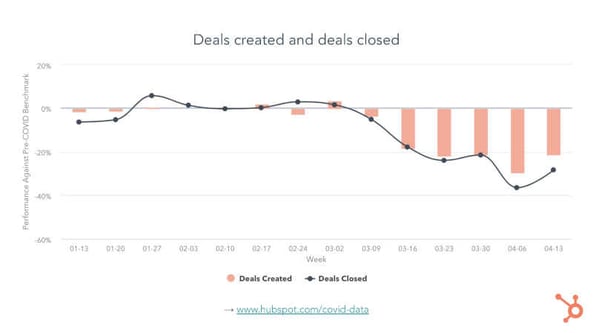
This data is from an aggregated benchmark data of the HubSpot user base of over 70,000 customers. Deals created and the deals closed during the last couple of months have really gone down after the COVID measures started to take place globally.
On a positive note, deal creation and other sales metrics are starting to pick up. However, we're still likely to be in this uncertain situation for a while, and most teams will stay remote for quite a bit, but if you're interested in getting more sales and marketing insights go to hubspot.com/covid-data.
Setting Up Your Remote Sales Team for Success - Brian Bresee
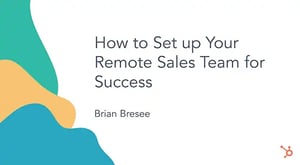
In this remote world, what are the fundamental things that you can do for your sales teams to help them perform at their best?

At HubSpot, remote workers make up our third largest office. If it were a single office, it would be the third largest globally. In the North American partner sales team about 40% of our 87 team members are working remotely today.
It's something we think about a lot at HubSpot and it's sort of how it started. When hiring fully remote reps we onboard, train and help them be successful in a remote environment.
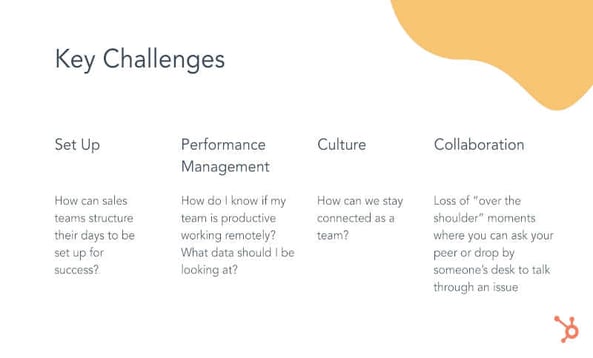
There are four key challenges.
- How to structure your day or can set up for remote to be successful
- Performance management.
- How can you build an inclusive culture and help your team to stay connected?
- Building for collaboration
“How do I know if my team's productive? How do I know that they're actually working and that output is good? What should I be looking at?”
Stats
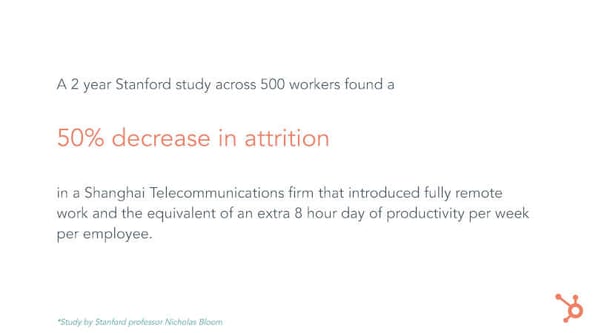
A lot of managers, business owners and leaders are worried about people moving remotely. It can be a really good thing. A two-year Stanford study of a Shanghai telecommunications firm showed it led to a 50% decrease in attrition. Over time, because they saved time on the commute, they effectively had an extra full work day of productivity by the end of the week.
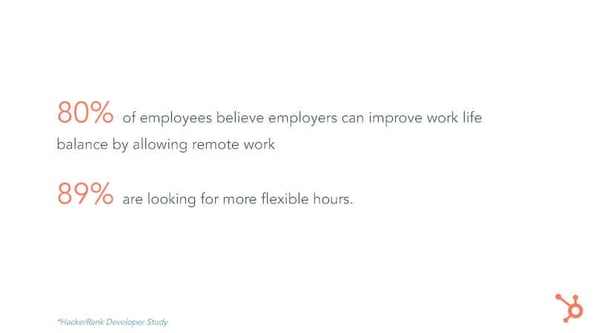
80% of employees believe that their employer can improve work-life balance by allowing remote work and 89% are looking for more flexible work hours.
In the early days of HubSpot when we looked at people who were moving from being in the office to remote, those who moved remotely on average saw a 10% increase in their productivity in the following year. The data is good both internally and externally.
You can rest assured that if you do the right things, if you help support your teams, often they work harder. Most of your remote people are going to overwork and may be at risk of burnout.
And so the question is: how do you shift your strategy in this world where we've all been sort of thrust into remote? It's happening at lightning speed. You may have no experience with it. There might not a lot of enablement around. So how do we do it?
1. Set-Up
How can you structure your day, and how can your contributors structure theirs?
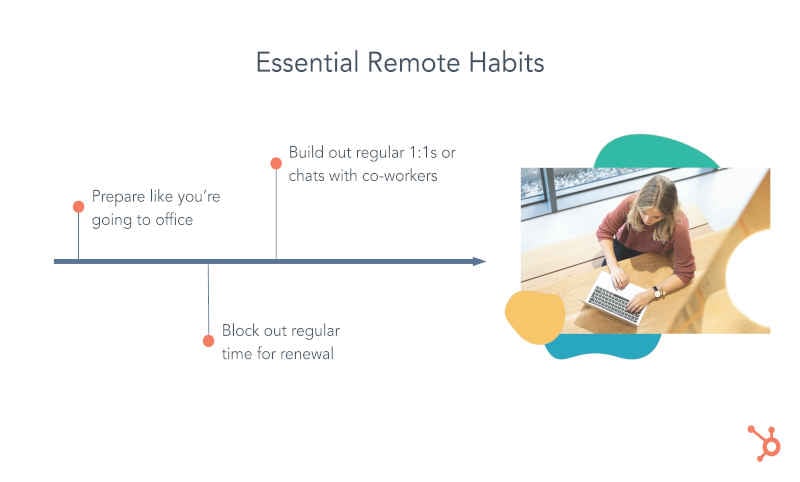
One of the big things is this context switching. For yourselves and your employees there's a break point between your home mode and your office work mode. There's a period in between it where you can get your head on straight, and your thoughts prepared and ready for the day. When you are working remotely, you don't have that same commute period where you can get mentally prepared, and this is important.
Essential Remote Habits
-
Prepare Like You’re Going to the Office. If you're working at home you may not have a dedicated office. That's okay. You probably want to think about a dedicated location or space. Even if it's just moving from your counter or your bed to a nook or a table, have somewhere that is a workplace and give yourself some time to prepare like you're going to the office.
What a lot of people do when they first move remote is they immediately jump on the phone. You wake up, pull out your phone, start answering emails, and then hop out of bed. You don't follow any of the habits that you normally would going to the office. What it does is it puts you in this defensive mode. You haven't had the time to prepare mentally.
Get up, get dressed, shower, dress like you're going to work, and take a little bit of space for that 'commute'. Maybe you listen to a podcast for 20 minutes. If you can walk outside in your current location, maybe you go for a short walk. Give yourself that space.
-
Block Out Regular Time for Renewal. How often have you forgotten to eat lunch since you've been working remotely? It’s a common thing and something that we have to be intentional about. Block out this time for renewal. It's easy to get sucked into your seat, so give yourself a little space, build yourself blocks to have a coffee and stop working over lunch and make yourself lunch.
-
Build Out Regular 1:1s or Chats with Co-workers. Especially if you don't know people well within your organisation or if you’re just not connecting as much with your teammates. Arrange regular one-on-ones with co-workers. One of the things that happens naturally in an office is people tend to connect. You run into someone at the coffee machine, you go for lunch with your teammates. With remote you have to program all of that and it's really easy to lose out and feel isolated. The purpose of these one-on-ones or chats is not to just talk about work.
You want to meet up with your teammates, your co-workers, especially people that you don't interact with as often, and have a coffee chat where you just talk through things in your life or get to know them a little better. It can be really helpful in building connections or networks like in the office.
Structuring Selling Remotely 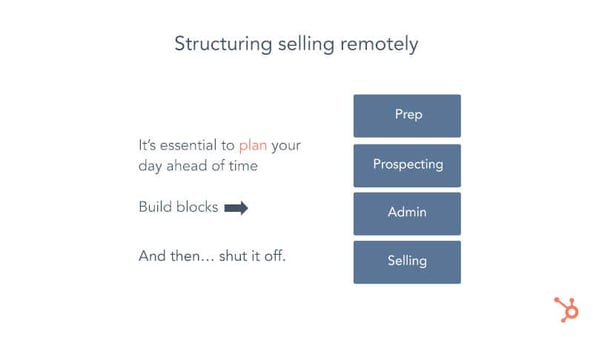
For yourself and your team structure can be one of the first things to drop. Take about 15 to 30 minutes at the beginning of your day to prep and plan. From there, have blocks for prospecting and outreach (if you're in a net new sales role), admin and then selling blocks. Without the energy and buzz of the office, it can be really hard to find motivation to prospect and make sales calls.
Setting up a predefined prospecting block can be a really powerful tool. You may suggest setting up some call blitzes where everybody calls at the same time, even though you're not in the same physical location.
You could have your team be a little competitive, and have a friendly competition around making the most dials within a pre-set period. Or pair up your teammates, and have them hold each other accountable to their calls. We're all sort of in this together, and it's important that your teams know and understand that as well.
Last thought on admin: a lot of reps get mired in their inbox. They get stuck with doing the 80% of activities that don't help with their selling. When reps first move to remote, blocking admin time can be helpful.
Put admin in an hour chunk of a day. That may mean not focusing on emails throughout the rest of the day, but it frees up that time to do essential selling activities – running product demos or prospecting outreach.
The last thing to note is it's really important to back to this idea of context switching. It’s really important to shut it off. You need to help your team shut off at the end of the day. They need to be able to context switch and go back to their personal life.
If you just work all the way through, you're going to be in a space where you don't feel like you ever shut it off. There’s high risk of burnout and that's super important to be careful of.
2. Managing Performance
From a performance management perspective, you want to have KPIs. At HubSpot, when we manage a sales team, we mutually agreed to have two new opportunities per day in the North American partner team. We know the data says that will lead to success based on historical averages. It's a very easy, very straightforward KPI. Another example might be touching 50 prospects per day.
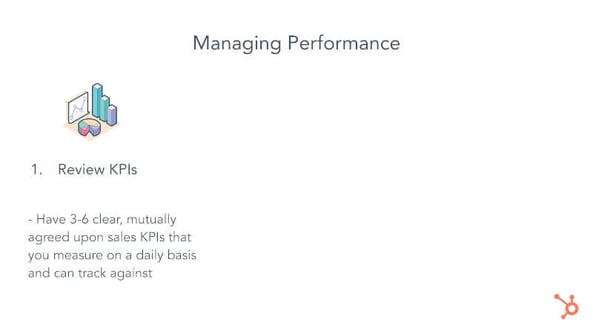
-
Review KPIs. You can use a system like HubSpot CRM or any CRM you like, but you need to have a system where you have mutual visibility into those KPIs. You agree on it with the team member and you're focused on it. Managing two KPIs is maybe the most important activity of a manager in a remote world. It's doubly important since you can't look over your shoulder and know that they're making dials.
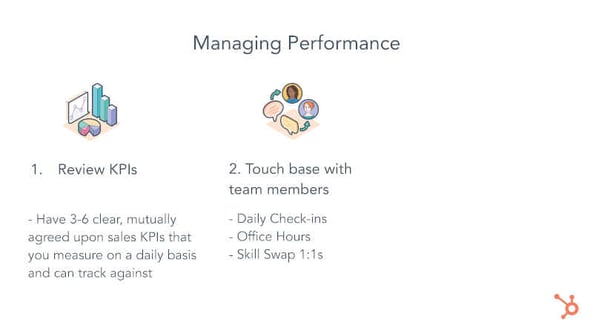
-
Touch Base with Team Members. Do daily check-ins with your newer folks. Have a blocked set of hours each week. Put an hour or two-hour block once or twice a week where people can drop in (e.g. leave a Zoom open to your team), work through stuff and make yourself a little bit more accessible.
One tactic for leaders is to arrange skill swap 1:1s. This is where team members can catch up with each other. For instance, if you’re the sales leader, you might find that one of your sales representatives is great at prospecting and one is fantastic at running a product demo. You suggest the two of them link up. Usually, they have different or complementary skills and you'll have them pass that information back and forth.
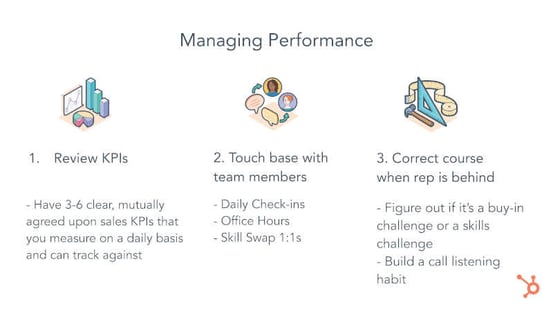
- Correct Course When Rep is Behind. Lastly, from a course-correcting perspective, you want to think through how to help your reps if they're behind. In a lot of cases, it's either a buy-in or a skills challenge. What we mean by that is if they're not making 50 prospecting touches, is it because they don't know how to find those 50 prospects? How to make those dials within the period that's allotted? Or is it because they actually don't believe that that's the most important thing?
Ask questions to understand where they stand. If it's a skills thing, have them bring up their screen, and help them show you what they're doing. You may find there's a space there (e.g. they're taking 15 minutes on a website to evaluate a prospect). You might be able to coach them and give them some advice that'll help them move a little bit faster.
If it's a buy-in thing, then you want to help them with what is most important and how they think they're going to achieve goals within this job if they don't do what’s been agreed upon. Understand their perspective and how they're thinking about it.
Lastly, I think that Gong is a really important tool. It's a call listening tool that lets you review your team's calls, and understand what they're saying and doing on the phone. It’s really powerful for HubSpot – we use it all day, every day to help coach and develop our reps.1
3. Culture
One of the biggest challenges for remote folks is staying connected. It’s really easy to feel isolated and disconnected from your team. As a leader, you want to think about how you're building that sense of connection for your sales team.
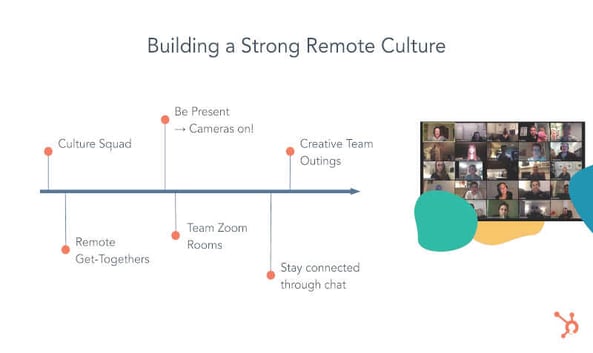
-
Culture Squad. At HubSpot, within a bunch of our sales divisions, we have a culture squad. They're essentially groups of sales reps who are volunteer teams dedicated entirely to making our culture better. It's rep governed, they get a set budget from leadership and they have complete autonomy with their mission being how to make the North American partner sales team more effective, have a better culture, be more inclusive, and be more diverse.
You can start small with this. You don't need to build a whole culture squad and create a budget for it if you don't have it. Look for the person who's most passionate about team connection and enable them to do something. Nominate a small group of people who take on the mission of keeping your team more connected while we’re working remotely.
-
Remote Get-Together. These are helpful. Everybody's heard of Zoom fatigue, where people are tired of getting on Zoom all the time. There is a sweet spot for timing this. You may not want to have a remote breakfast every single morning, but once every couple of weeks, or weekly, take an hour where the team can jump on Zoom and do things like get lunch or dinner delivered from a local restaurant.
Try to remove work talk. Have folks answer a fun question so you're not talking about COVID or things in the workday. Shut those things off and just get to know each other. An example might be: “What's the last song you listened to on Spotify?” or “What's a significant event from your childhood?” The idea is you're getting people to open up and get to know each other a little bit better, be a bit more vulnerable or open.
-
Be Present. Keep your cameras on. A lot of folks turn the camera off by default. But it's really helpful to be able to see people if cameras are on.
60%ish of communication is based on body language and facial cues, so if you're just getting verbal, it contributes to that feeling of disconnection.
-
Team Zoom Rooms. These are helpful for teams that are focused on execution. If you have a sales team where a good chunk of your work is not live on the phone, say, have a Team Zoom Room that's always open.
Set up the Zoom Room, leave it open and people can pop in and out. It lets you build a sense of connectedness via video. If you're executing and you're writing up a statement of work or a proposal, you can jump in and be working next to folks to give that office feel.
-
Creative Team Outings. This could be something like doing board games online. Get each member to send in a fun fact or three about themselves and create a trivia game where you guess which team member was the fact about. It's a fun way to get to know the team and get some wild and interesting facts. Other things could be Jeopardy, a Team Spotify playlist, team workouts, a yoga class or meditation.
Some of this is dependent on the team. You may have to do a little bit of digging to come up with ideas that are compelling and interesting to your team, but ultimately what you're trying to do is build events that create that connection.
4. Collaboration
A lot of sales leaders worry about the lack of 'over-the-shoulder' moments in remote working. For example, overcoming a lack of access when getting a new team member up to speed, or talking through an issue in real time.
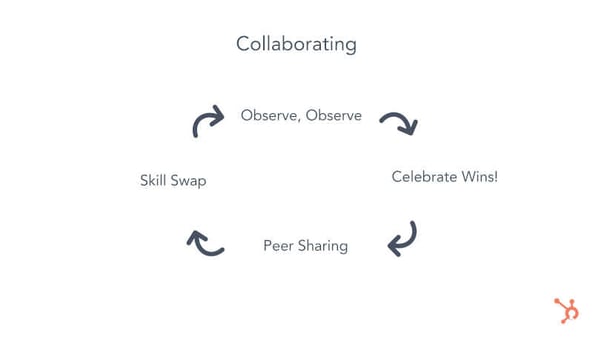
-
Observe, Observe. One of the biggest things that you can do is reframe how you think about supporting people from a selling perspective. Don't look for what there is to improve – everyone's had a manager who gave you five or six pieces of feedback and it was overwhelming. You want to find what it is new members are doing well that you want them to keep doing.
Spend more time looking at what they're doing well that they can they can get recognised for. Gong lets you do that when you listen to recorded calls.
-
Celebrate Wins. Record through Zoom and have folks share those top moments. If you find something cool share it with the team or with the group. Ask the team members, even if they're new, to bring it to a team meeting and share it and run a discussion around this tactic that they tried. This lets us celebrate some wins and also gives them a bit more confidence for selling.
One of the biggest hurdles is the confidence that you're going to be great at selling. So if you can help them to build that confidence by giving a bunch of positive reinforcement it's going to be helpful.
-
Peer Sharing. 80% of our remote team meetings are conversations. Don't drive an agenda. Have a couple of issues to talk about where everybody's participating, get to give some perspective and ask questions.
Often, a top performer sharing how they do something helps the rest of the team.
-
Skill Swap. Keep a mental or written log of the strengths and weaknesses of different folks on your team. Connect complementary people. This is doubly important in a remote world because you’re intentionally helping people find time to connect.
How to Get Your Remote Sales Team to Hit Target - Andreï Sochala

The other part of the remote working equation is the economic crisis which we’re in. This is a unique moment which makes the main objective of any sales team - hitting targets - quite difficult.
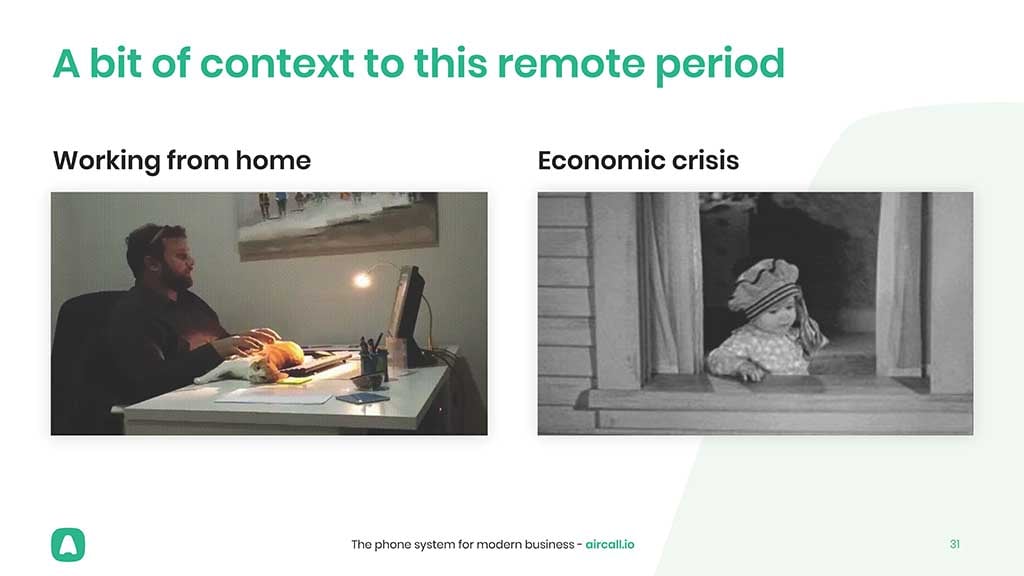
For most sales teams it's probably a challenge right now. The situation is tough but companies still expect sales teams to hit targets.
As a manager starting to explain the situation to your team, run through what’s going on in the head of your CFO or whoever's running your company right now.
This moment of transparency might help your sales team understand why the company is still expecting them to hit targets amid this new situation.
When it comes to hitting targets, if you're in the sales world today you know that it comes down to prioritising your time. Let's talk about how you can try not to miss any of those few remaining revenue opportunities by being laser-focused.
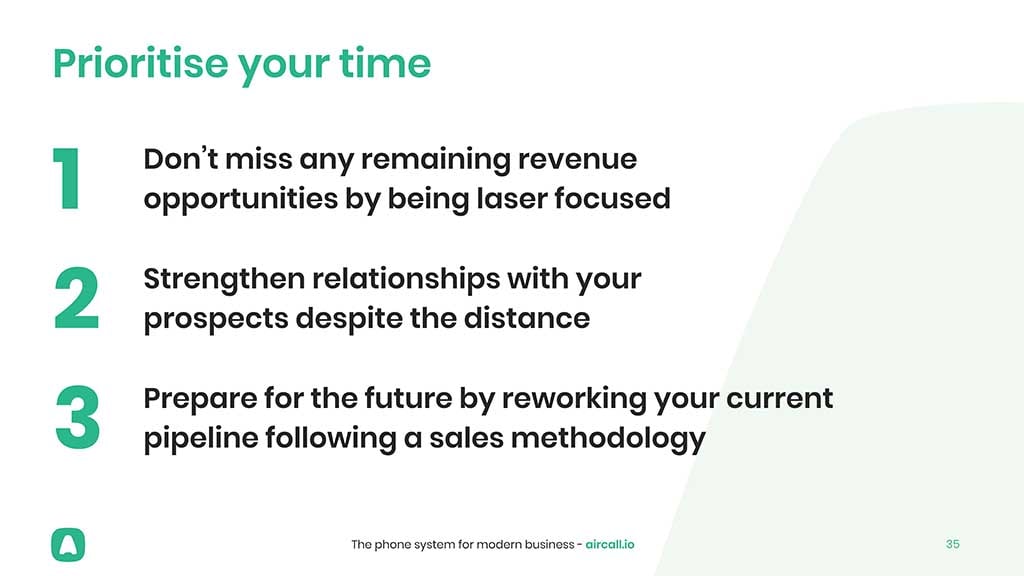
We'll also talk about how you can strengthen the relationships with your prospects despite the distance. This is something that might help you achieve targets at the end of Q2 or Q3.
Finally, we’ll discuss how can you prepare for the future by reworking your current pipeline, following a sales methodology.
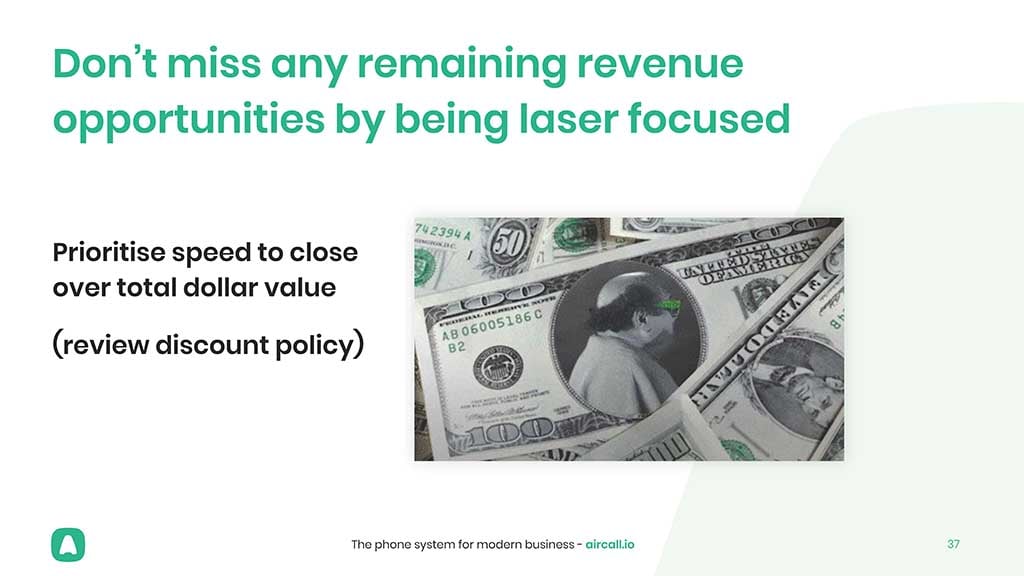
Don’t miss any remaining revenue opportunities, by being laser-focused. Start going into the few remaining revenue opportunities that are there and don't let them go. While this might sound slightly obvious, this is where you must leverage your CRM all the more.
Use your CRM to cherry-pick which opportunities to dedicate extra time to. This is where you and your sales reps can dig into your CRM to find opportunities which are currently open but can be closed. In sales, you should always focus on the stuff that can close, but this is all the more true now.
It's not only about looking at what's in your pipeline. It's looking at all the other little details, like free trials. Don't let go of any of those ops that are about to close. If you are a manager spend the extra time helping your reps close those ops.
Prioritise speed to close over total dollar value. What does this mean? In the current context, if you have the opportunity to get a commitment this week, or in the next couple of days, even if the total amount might be lower than what you had previously expected, do it.
Adapt your key selling points to the situation. As a sales rep, take the time to recognise the situation and think about what aspect of your product can help your customers today. This can change.
As an example, Aircall is a cloud-based phone system which integrates with the best CRMs in the market, of which HubSpot is one. Our key selling point initially was the fact that we're a cloud-based phone system. We were able to help companies switch from working from their office to start taking calls remotely.
But after a couple of days, that was no longer the key selling point. We were not the only cloud-based phone system on the market.
We talked to our prospects and customers to understand what was important to them. We found that from the sales reps' point of view, call quality was the most important thing.
From the management side, analytics and live call monitoring were what people were missing with their phone system. Those are the two arguments that we pushed through over the next couple of days.
Discipline and responsibility.
Finally, in this current situation, to hit those few remaining revenue opportunities, you may want to sometimes do things that might not seem as scalable as opposed to what you would be doing in any different context. Applying as much discipline and responsibility to your tasks, which can be something as obvious your own personal to-do, is important.
Even as a sales rep, with those couple of deals that you can really close the next couple of days or weeks, you want to be working with them in a very smart and very detailed way. Going back to tasks and maybe forgetting a little bit about what makes you work in a nice scalable way in any other type of context might be helpful.
Strengthen relationships with your prospects despite the distance.
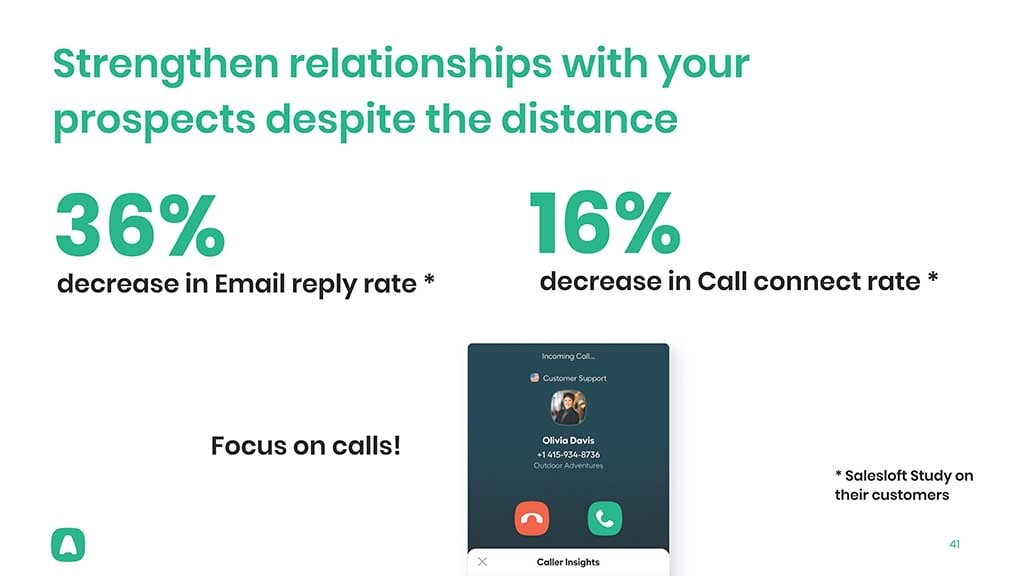
-
Talk to your prospects. A company called Salesloft observed a 36% decrease in email reply rates. At the same time, they observed a 16% decrease in call connect rates. The difference between the two is huge.
What this means is that in today’s context, people are more receptive to calls. That's what your sales reps should be focusing on calling their prospects and building the relationship.
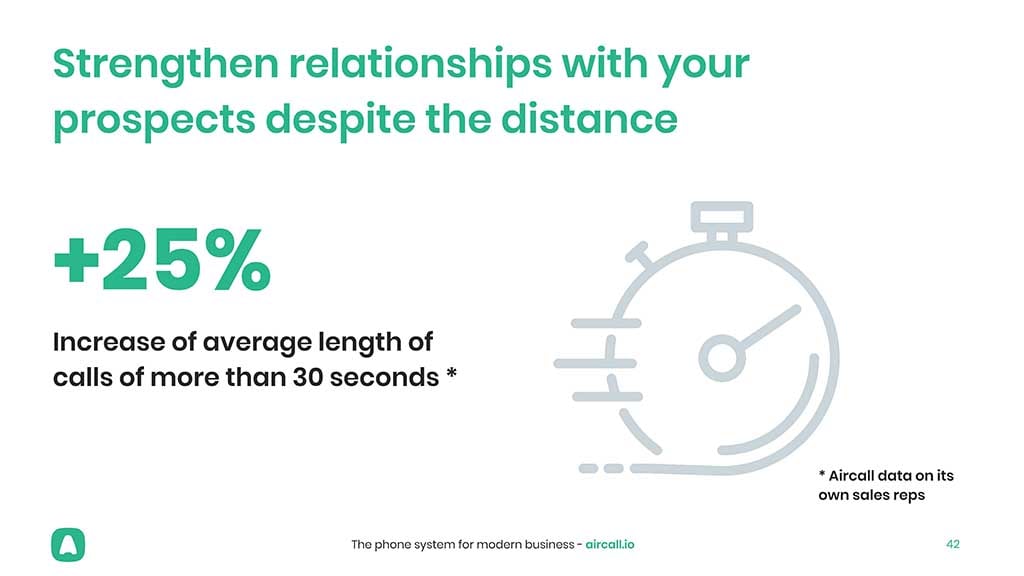
We looked at all calls that connected for more than 30 seconds and we saw a 25% increase in the average length of those calls. This means that prospects and customers are more open to talking. And if they're more open to talking, you can gather more information about them, their companies, and their current challenges.
This is information that you can log in to your CRM and use later.
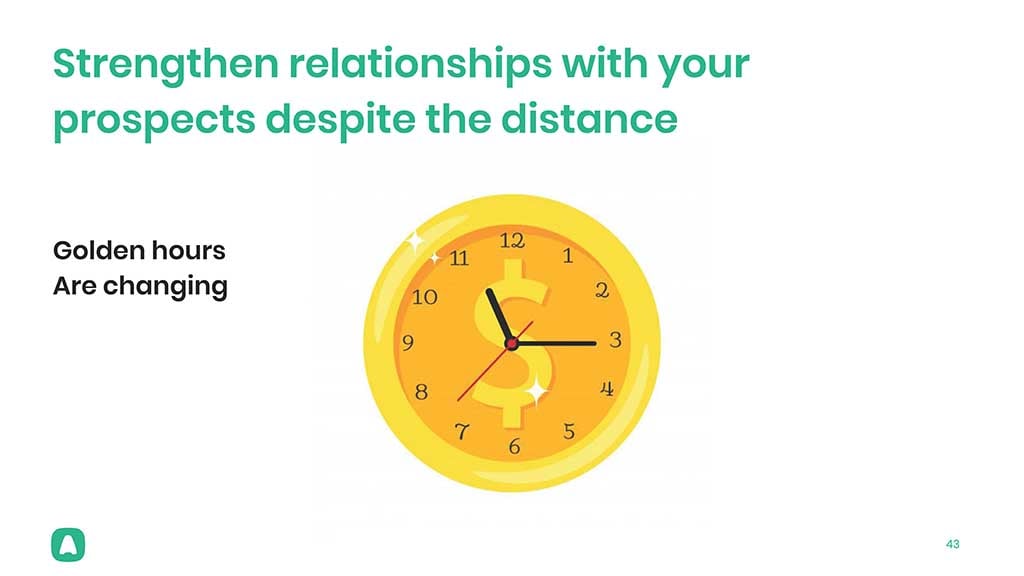
-
The Golden Hours are changing. Golden hours vary from one country and industry to another, but we observed that the number of insightful calls has more or less spread across the day, whether it be incoming calls or actual sales.
Simple things like having a mobile app that receives your sales calls might allow you to receive those few incoming calls you may otherwise have missed, and get those deals in.
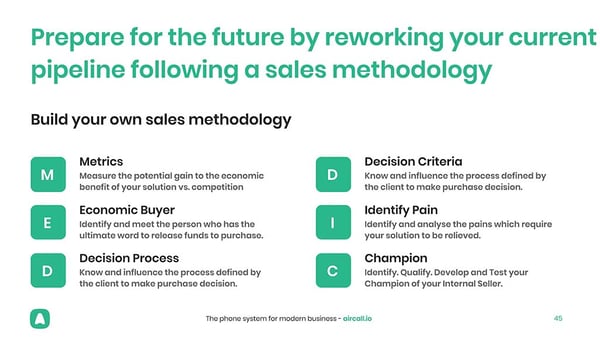
-
Prepare for the future by reworking your current pipeline following a sales methodology. The current situation is going to change. Things are going to come back progressively.
Re-working your current pipeline following a sales methodology is something people tend to keep as a side project. Now you might have some time.
One of the sales methodologies that has inspired our own at Aircall has been MEDDIC, which is one of the most famous. Ask your sales reps to give you all the information on metrics, economic buyer, decision process(es), decision criteria, and pain points for each of their deals. You might realise that you still have a lot to uncover about some ops.
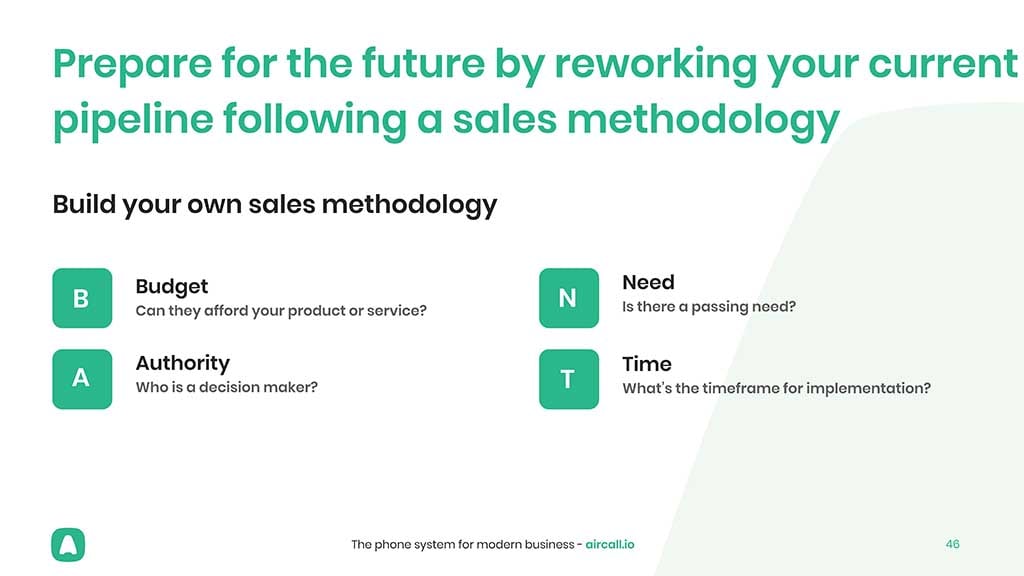
Another classic sales methodology is BANDS. What's the budget to close the deal? Who has the authority? What's the need? What's the timeline? Don’t use MEDDIC or BANDS directly, but take inspiration from those sales methodologies to build your own. Once you have your own framework, apply it to your current pipeline.
Finally, once you've done this you'll be able to show that you own your pipeline and assert your value and relevance within the company. This will show that even though you might not be able to hit your April target, May target, or Q2 targets, you still have a plan. You still have different pathways to reach these end-of-2020 targets.

Thanks to Brian and Andrei for their insights and helpful suggestions. If you've discovered any useful tips for remote working let us know in the comments.
Good luck to all teams dealing with these new challenges.



